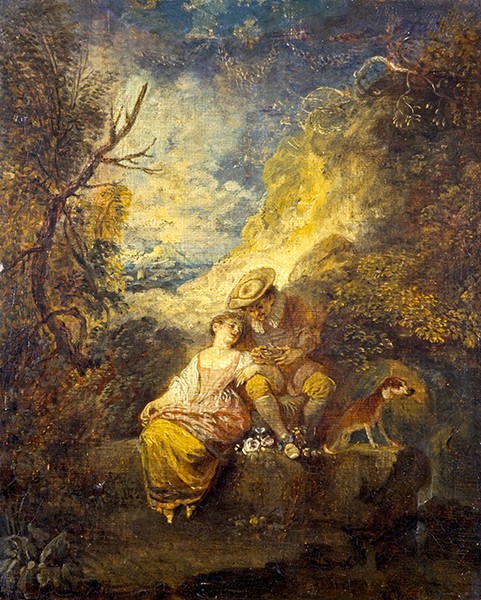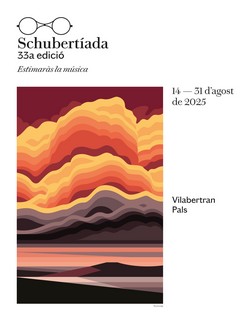Elisabet Barroso is the master's student visiting us this week; she tells us about a mélodie by Claude Debussy with a poem by Paul Verlaine: En sourdine. To musically illustrate her article, she has chosen a recording by Elly Ameling and Dalton Baldwin. Thank you, Elisabet!

To evoke a specific sensation in a listener is not a simple task: to transmit this particular emotion, and not another must be done skillfully. Paul Verlaine, the author of the poem En sourdine, found a magnificent way of doing so. Moreover, we have been lucky that Debussy provided the poem with a new musical dimension by exalting the words of Verlaine with elegance, subtlety and delicacy, well known of the great master.
Those who have some notions of French know what the title En sourdine means: silenced, or muted. And, which vocal makes us close the mouth in French? Indeed, the ə. This neutral sound is a kind of e with the mouth of an u. We find many of these vowels here, which will force the singer to sing this mélodie with the mouth "half closed." I find wonderful Verlaine’s ability to create this effect and transmit the silence that he had already announced that will take place with the title.
However, at this point, a very interesting and recurrent debate has been opened in the world of Lied. When we sing, do we have to pronounce exactly as we would talk? How can one sing expressively if one has to sing with his mouth half-closed? In this mélodie, the great majority of singers will compete to make the vocal œ, not the ə, which will allow them to open the mouth a little more, so they can get more harmonics and rounded sound. But, to what extent should we respect the spoken word to adapt it to the singing vocal needs? This very extensive debate is still in force nowadays.
I think Verlaine’s purpose for this poem was to make the reader feel a silent peace. He makes us feel what he wants us to feel through symbolic suggestions. We have not said it yet, but Verlaine was a precursor of symbolism. He was not interested in describing the feelings, like the romantics would have done. Instead, he made the feelings come in a more corporeal way so it would expand through the reader's body without him rationally realizing what was going on inside him: he simply wanted the reader to experience it.
Going into more detail in the poem, En sourdine belongs to the collection of 22 poems entitled Fêtes galantes. This collection has a great ambivalence, as it is set at the same time in the elegant and cold society of the eighteenth century and also in the melancholy joy of the characters of the Commedia dell’Arte of Bergamo.
We are presented in front of a fictitious reality, an unreal universe. The poems also evoke the paintings of Antoine Watteau, who was the creator of the pictorial genre that bears the same title of the collection, Fêtes galantes. The canvases that are part of this genre often represent country and bucolic scenes, an ideal world, where pleasure, courtly love, and the characters of the Italian Commedia dell’Arte are a constant.
Debussy loved ambivalences, he was fascinated how something could sound both melancholic and joyful at the same time. In addition, he had a special way of composing: he used to build music sentence by sentence, and not, on the contrary, absorbing the sonority of the whole poem and making music from it. At first glance, it may seem that the music may be fragmented, but it is not: the music accompanies the text in a way that makes it shine even brighter.
Debussy finds a superb way to reflect in his music everything Verlaine wanted to express. To begin with, the most obvious: if the mouth hardly moves to pronounce the poem, the notes to sing it, either: the singer will stay almost the entire first sentence suspended in a d#. And throughout the melody we do not find big jumps, but quite the opposite: we experience a stillness, both in the phonetic and in the melody, which often moves by the short distance of a semitone.
However, if everything were quiet, it would be hard to get the feeling that the music is moving forward. To break it, the piano is essential. In the very beginning, in the second bar, Debussy writes a triplet that will appear throughout the piece. It reminds me of a bird…Its identity will not be revealed until the end, but we will see that it is a nightingale, perhaps the most popular bird in poetry? The texture of the piano and this nightingale give great fluidity to the poem and the singer.
Going now closer in detail of the melody, let's look at the text of the first section. If we look at the score, we can see that the most obvious feature is steady rhythmic values, crotchets and quavers, both on the piano and in the voice. If they were both played at the same time, it would be too static, but Debussy arranges them in a creative way providing a wonderful effect which alternates the roles. Now the piano enters in offbeat, now the voice does it. The music comes into a quiet swing, which gives us a feeling of being floating within a timeless affability.
The second section of the piece is quite different in texture. We can see that we need to make more vocal changes, because now the text no longer has this phonetic closure. So, by having this phonetic opening, we will also have an opening in the melody and in the piano. However, we will not find great melodic jumps, as it would break with the overall quiet aesthetic of the poem.
At the moment Intimement doux we have some exquisite harmonies, which accompany a voice that, for a few moments, seems to have returned to the beginning: a calm staticity accompanies this laissons-nous persuader. Maybe he wanted this request to sound more powerful by asking it in a delicate and subtle way? This poem is full of hidden, sinuous sensuality.
Let’s take a look now at the third section of the text. Here, Debussy, with great subtlety, transports us to the same sonority of the beginning. All the openness we had passed, now begins to dissipate in order to return to the initial closed calm. In bar 36, the singer has a moment of silence to gain strength and climb to the highest and most enigmatic note of the whole piece, in the word voix. Voix de notre désespoir, le rossignol chantera. Perhaps Debussy wanted to exalt that despair, as if it were a gasp? There’s something dark in this ending where once again I find the ambivalence: the chords are sweet, kind, the nightingale sings… But the evening has fallen, and the nightingale sings, but only to accompany our despair.
We are at the end, and we feel again a cloud of kindness suspending and accompanying us gently to the last note, sung by the nightingale. Their triplets, agile and sweet, end up resting in a g#, creating a sixth major in this final chord of B major. It will be strange if Debussy closes his work with a fundamental triad chord, so we usually find some note outside this classic chord, which will give us a different touch of color, the always so characteristic touch of color of Debussy. Because, isn’t it easy to confuse Debussy with a painter?
About the author
As a pianist, it could be easy to neglect the subtle nuances from the singer I am playing with. Maybe I could merely pay attention to her breathing pace to synchronize our rhythms and that would be enough. But I have always been willing to walk the extra mile: Since I was a little child I have been fascinated by the spoken language. I even enjoy to speak them when I do not know exactly what I am saying! These are the reasons that have to lead me to truly enjoy Lied. What really stands out for me is its ability to combine the arts of word, singing and piano.
Calmes dans le demi-jour
Que les branches hautes font,
Pénétrons bien notre amour
De ce silence profond.
Fondons nos âmes, nos cœurs
Et nos sens extasiés,
Parmi les vagues langueurs
Des pins et des arbousiers.
Ferme tes yeux à demi,
Croise tes bras sur ton sein,
Et de ton cœur endormi
Chasse à jamais tout dessein.
Laissons-nous persuader
Au souffle berceur et doux,
Qui vient à tes pieds rider
Les ondes de gazon roux.
Et quand, solennel, le soir
Des chênes noirs tombera,
Voix de notre désespoir,
Le rossignol chantera.
[1st section]
Calm in the twilight
Cast by loft boughs,
Let us steep our love
In this deep quiet.
Let us mingle our souls, our hearts
And our enraptured senses
With the hazy languor
Of arbutus and pine.
[2nd section]
Half-close your eyes,
Fold your arms across your breast,
And from your heart now lulled to rest
Banish forever all intent.
Let us both succumb
To the gentle and lulling breeze
That comes to ruffle at your feet
The waves of russet grass.
[3rd section]
And when, solemnly, evening
Falls from the black oaks,
That voice of our despair,
The nightingale shall sing.
(translation by Richard Stokes, from A French Song Companion (Oxford, 2000))














Comments powered by CComment